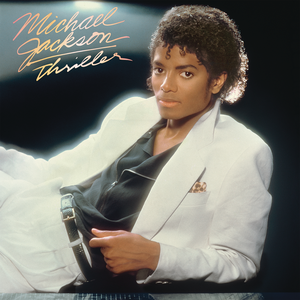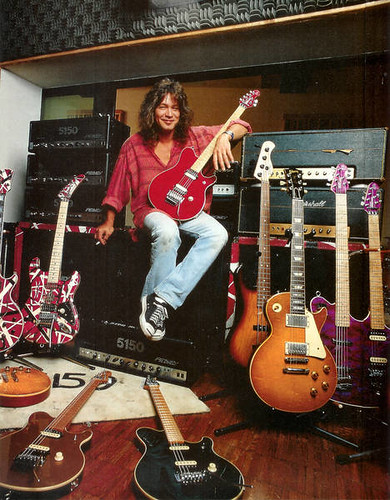Unusually for a rock guitarist, Eddie Van Halen also periodically used keyboards in his music too. It is this unusual touch about Eddie that makes him a true musical prodigy, and a gifted one at that.
1984 was the first Van Halen album to feature prominent keyboards in the music.

Picture courtesy https://en.wikipedia.org/wiki/1984_(Van_Halen_album)
Why the experimentation with keyboards? A few reasons. Number one, many people are unaware that both Eddie and Alex undertook strict piano lessons during their childhood, until they both discovered rock and roll. It even reached the point where they performed in concerts as pianists when children. However, once they had enough and Ed bought his drum set, it all changed.
The second reason is as the trends changed in rock music, particularly during the 1980s, keyboards suddenly became acceptable within the rock framework and many popular artists of all genres used them throughout this period. It seemed like a good idea for the band, now on the rise, to use them fairly extensively in their music.
A key point for many understanding the use of keyboards in Van Halen’s music was “Beat It” on the Thriller album by Michael Jackson, which EVH collaborated on.

Picture courtesy https://en.wikipedia.org/wiki/Thriller_(Michael_Jackson_album)
The final reason, perhaps, is down to Ed’s personal preferences. Being the innovator that Ed is, he decided to fiddle around with keyboards early on, despite hostility from others in the Van Halen circle, and eventually won. Without Eddie’s persistence on the matter, some of the music from Van Halen in this period would have been vastly different, and possibly much worse.
It all began with the experimentation of the keyboard on “…And The Cradle Will Rock…” on Women and Children First where Eddie plugged a Wurlitzer keyboard into his Marshall stack. It was accepted at the time, as the sound was not dissimilar from Ed’s famous Frankenstrat, which was entirely intentional. But in particular, David Lee Roth and long-time producer Ted Templeman would not accept the keyboard alone whatsoever. This led to massive arguments between Eddie and the others about the creative direction of Van Halen. On the 1980 tour, Michael Anthony was noted as playing the keyboard part on his bass guitar for the song, which must have been humiliating for Ed.
Eddie realised he had much more power with creating his own music than allowing others to do so for him, hence the 5150 studio.

Picture courtesy http://www2.gibson.com/News-Lifestyle/Features/en-us/flashback-eddie-van-halen-on.aspx
Synthesizers were present on the next album Fair Warning on the track, “Sunday Afternoon In The Park”. By this point, the original incarnation of Van Halen was suffering from some problems with personal relations reaching new lows. But still, the band powered on.
Diver Down, a record that neither Eddie nor Alex Van Halen were particularly happy with had an interesting keyboard part on “Dancing In The Streets”. But it was a cover, and Eddie was unhappy with the fact that what he intended for an original composition was literally hijacked for other purposes. Still, Eddie Van Halen persisted at his dream of using keyboards to supplement Van Halen’s music.
Diver Down, although perceived as a failure by the two Van Halen brothers, was simply paving the future for keyboards and the 5150 studio.

Picture courtesy https://en.wikipedia.org/wiki/Diver_Down
The answer to Ed creating his own sometimes keyboard heavy music was to establish his own studio. Named after the police code for a lunatic on the run in the Los Angeles area, 5150 was built inside Ed’s own home and was completed in 1983, when Van Halen had begun work on what would eventually become the 1984 album.
From this point onwards, no person but Edward Van Halen could claim responsibility for the most part, of Van Halen’s music. The next album, 1984 had the band’s single biggest hit, “Jump” which had an Oberheim OX-Ba keyboard piece recorded on it, dominating the #1 U.S. chart hit in the year of release.
Ed also ventured out, and for a considerable period of time during the 1980s playing keyboard onstage. This was a more interesting touch and a different side to Eddie Van Halen, but one that did not last. As time went on, keyboards became unfashionable to the mainstream music scene during the 1990s as trends changed, and instead offstage session keyboard players and/or sequencing machines played keyboard parts so that Eddie played the primary guitar lines on stage instead, rather than playing the parts himself.
However, this experimentation with keyboards ultimately proved fatal to the first incarnation of Van Halen, with David Lee Roth leaving the scenes in 1985 along with Ted Templeman. The band then had other priorities to deal with from that point onwards. Still, it was Eddie’s ingenuity that won the day, and proved that he was no one trick pony.
Until this day, the 5150 studio has remained the basis of Van Halen’s music recordings and creation.

Picture courtesy https://www.flickr.com/photos/43908441@N00/4160283836
References:
- Renoff, Greg. 2015. The History of Eddie Van Halen and Keyboards. http://ultimateclassicrock.com/eddie-van-halen-keyboards/
- Rosen, Steven. 2008. Flashback: Eddie Van Halen on 1984. http://www2.gibson.com/News-Lifestyle/Features/en-us/flashback-eddie-van-halen-on.aspx
